
Lagerstroemia, Crepe Myrtle: Planting, Growing and Care
Contents
The Lagerstroemia in a nutshell
- The Lagerstroemia, also known as Crepe Myrtle, is a beautiful bush or small tree with spectacular summer flowering in Indian pink, red, mauve or white
- Its ornamental foliage bursts into autumn colours ranging from purple to reddish-orange
- Its remarkable bark and elegant silhouette make it highly decorative even in winter
- Fairly hardy and undemanding, it only requires full sun and warmth
- Some varieties are quite compact and adapt perfectly to container growing!
Our expert's advice
The Lagerstroemia or Indian Lilac is a bush that is both spectacular and refined. Its vibrant flowering occurs from July to September in Indian pink, incandescent red or baroque white. To maintain attention, its foliage sets autumn ablaze with purple and orange-red hues. In winter, it becomes delicate by revealing remarkable bark, satiny, cinnamon-coloured and marbled with soft, rosy and creamy tones. With the subtle colours of its branches and its slightly twisted habit, the Indian Lilac elegantly embraces winter nakedness. On the contrary, the fact that it is deciduous further highlights its architecture and the appearance of its branches!
Thanks to its good hardiness (down to -15°C), it can be grown in most of our regions, although it prefers a warm and sunny spot to fully showcase its flowering.
The summer lilac has a natural coppice shoots habit, but it can also be trained as a standard or pruned into a small, graphic bush. There are also compact varieties, which are perfect for pots! It’s the ideal bush when you have limited garden space: it’s beautiful all year round and can be kept to manageable sizes.
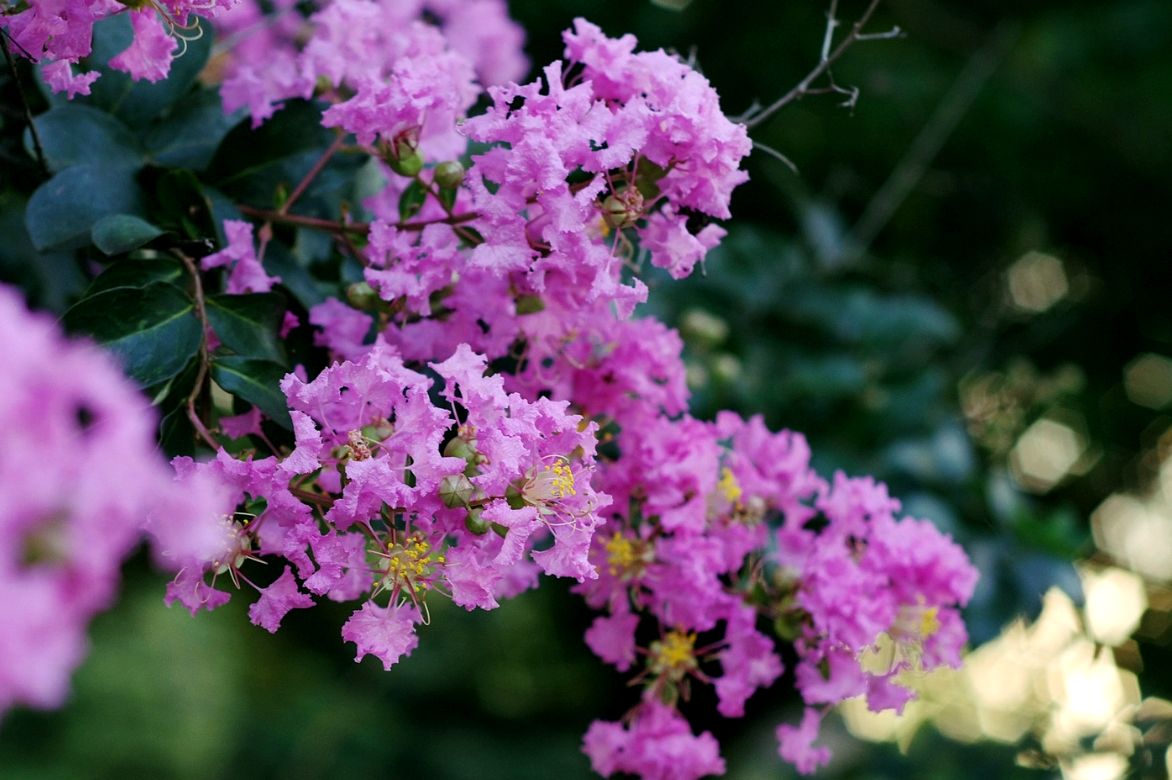
Inflorescences of an Indian Lilac (photo Otota Dana)
Description and uses
Botanical data
- Latin name Lagerstroemia indica
- Family Lythraceae
- Common name Crape myrtle, Indian lilac
- Flowering July to September
- Height typically between 2 and 7 m, sometimes less for dwarf varieties
- Exposure full sun
- Soil type any well-drained soil, preferably rich and moist. Tolerates drought once established
- Hardiness -15°C
Although commonly called Indian lilac, the Lagerstroemia actually originates from China. Imported to the Indian subcontinent for its beauty, it was later introduced to England around 1740, and more recently to France. There are about thirty species, but the most well-known and cultivated in gardens is Lagerstroemia indica, along with the numerous horticultural varieties it has produced. Other cultivated species include Lagerstroemia fauriei and Lagerstroemia speciosa.
The crape myrtle is a deciduous bush with dark green foliage that turns fiery red in autumn. The leaves are leathery, with a very short petiole, almost absent (they are described as subsessile). They are opposite, entire, ovate and acuminate. The foliage appears late in spring and disappears in late autumn, highlighting the bush’s architecture. The branches are quadrangular.
In July, the flowers bloom in panicles 10 to 20 cm long. Each flower consists of 6 crumpled, fringed petals with undulate edges and numerous yellow stamens. These frilly features have earned it the nickname ‘crepe flower tree’ or ‘mousseline flower tree’. Depending on the variety, the flowering ranges from pale pink to fuchsia, but can also be red, mauve or white. The Lagerstroemia’s flowering is truly impressive! The flowers are abundant, brightly coloured and tend to hide the foliage during summer.
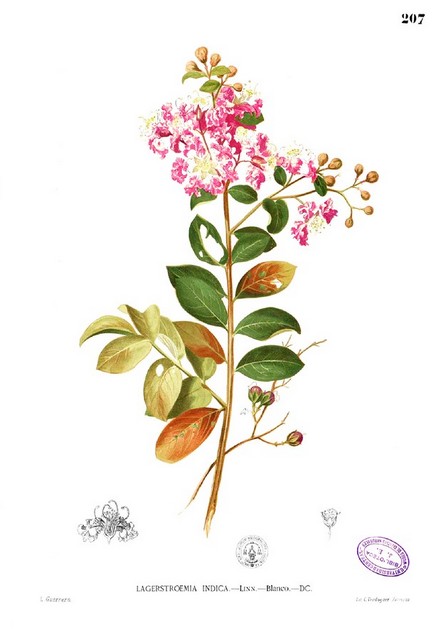
Lagerstroemia indica – botanical illustration
Its small fruits, less than 1 cm in diameter, mature into blackish capsules containing numerous small winged seeds. They are toxic.
Its natural habit is bushy, but it can be trained as a standard, forming a single trunk with branches, leaves and inflorescences at the top. Thanks to its compact size and non-invasive roots, it can be planted close to buildings or utilities. This is a great advantage: placed near a window, its foliage will provide light shade in summer, while in winter its beautiful bare branches will let in light. In this case, choose smaller trees like Lagerstroemia indica ‘Natchez’ with its huge white spikes.
When left to grow naturally, the Lagerstroemia has an elegant, slightly twisted silhouette, reminiscent of Japanese maples. Paired with spring bulbs, ferns and broad-leaved hostas at its base, the effect is perfect, especially if you choose more subtle-coloured varieties like L. indica ‘Pink Grand Sud’.
A polymorphous bush, its uses are varied. It can be planted as a specimen to showcase its flowering and habit, whether bushy or trained as a standard. You might then choose taller varieties like L. indica ‘Violaceae’, while the slightly prostrate Lagerstroemia indica ‘Mardi Gras’, not exceeding 1 m in height, is perfect for rockeries or attractive containers. Indian lilacs blend beautifully at the back of borders or in informal hedges, where they add an exotic touch with their unusual colours.
The Lagerstroemia is easily grown in containers, which is a great advantage, as it is beautiful in every season! Among many compact cultivars, Lagerstroemia indica ‘Berlingot Menthe’, which doesn’t exceed 1.5 m and bears small frilly Indian pink flowers edged with white, will stylishly decorate a sunny balcony.
Its tolerance of hard pruning, the aesthetics of its habit and the beauty of its bark make it an ideal candidate for bonsai training.


Flower shades: Lagerstroemia indica ‘Pixie White’, Lagerstroemia indica ‘Summer Shades’, Lagerstroemia indica ‘Lilac Grand Sud’ (©Hortical Diffusion), Lagerstroemia indica ‘Pink Velours’ (photo Jimthe), Lagerstroemia indica ‘Dynamite’ (©Minier)
The main varieties of Lagerstroemia

Lagerstroemia indica Rhapsody in Pink - Crape Myrtle
- Flowering time September to November
- Height at maturity 2,50 m
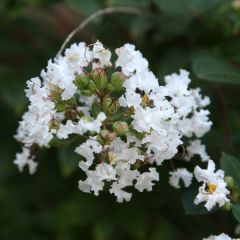
Lagerstroemia indica Pixie White - Crape Myrtle
- Flowering time August to October
- Height at maturity 1,20 m

Lagerstroemia indica Camaïeu dEte Indycam - Crape Myrtle
- Flowering time August to October
- Height at maturity 2,25 m
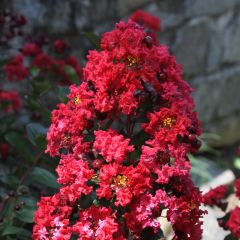
Lagerstroemia indica Dynamite - Crape Myrtle
- Flowering time August to October
- Height at maturity 4 m
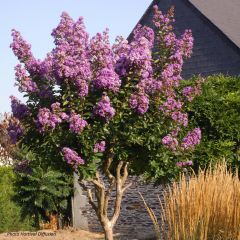
Lagerstroemia indica Lilac Grand Sud - Crape Myrtle
- Flowering time August to October
- Height at maturity 3,20 m

Lagerstroemia indica Braise dEté Indybra - Crape Myrtle
- Flowering time August to October
- Height at maturity 3,50 m
→ Further reading:
Discover other Lagerstroemia - Crape Myrtle
View all →Available in 2 sizes
Available in 1 sizes
Available in 1 sizes
Available in 2 sizes
Available in 1 sizes
Available in 2 sizes
Available in 1 sizes
Available in 1 sizes
Available in 1 sizes
Available in 1 sizes
Planting the Lagerstroemia
Where to plant
The Lagerstroemia needs warmth: choose a sunny spot sheltered from the wind. It is content with ordinary soil but prefers slightly acidic, cool and well-draining ground. It dislikes chalky soils or areas that retain moisture in winter. Once mature, it can withstand drought. Similarly, it is quite resistant to pollution and can therefore be planted in urban areas.
While it does prefer some atmospheric humidity, once well-established it can endure dry and scorching summers! Its only requirements for spectacular flowering are sun and warmth.
You can plant it in a hedge, place it at the back of a flower bed, in front of perennials, or even as a standalone feature in the middle of a short grass meadow to highlight its unique architecture. The Lagerstroemia can also be grown in a pot and adapts rather well to small gardens. However, for optimal growth, planting it in the ground is ideal.
When to plant
In regions with a mild climate, the ideal time to plant Lagerstroemia is autumn (October-November): the still-warm soil encourages good root establishment, and the rains will spare you from regular watering after planting. You will still need to water during the following summer until the bush is well-established.
In cooler regions, prefer planting in April-May, as this will allow it to establish well and benefit from the summer before facing winter. However, if planting in spring, it will be important to water abundantly during the summer.
How to plant
In the ground:
- Place the container in a bucket of water to thoroughly hydrate the root ball.
- Dig a hole 2 to 3 times the size of the root ball.
- Remove the bush from its pot and prepare the root hairs: untangle the roots around the root ball and trim any damaged or tangled roots.
- Fill the bottom of the hole with a mix of soil and well-rotted compost. If your soil is very heavy, first lay a bed of gravel or pumice for drainage.
- Place the plant in the hole, spreading out the roots.
- Backfill with the soil and compost mix (optionally adding gravel if your soil is heavy). Ensure the collar (the junction between the roots and the trunk) is level with the soil surface.
- Create a small mound of soil around the planting hole to form a basin that will retain water.
- Firm the soil lightly and water generously to help the planting soil adhere to the root ball.
After planting, we recommend applying a mulch (wood chips, bark, dead leaves…) to keep the soil cool.
In a pot:
Choose a pot at least 60 cm deep to give the roots ample space. Ensure there are drainage holes to allow excess water to escape.
- Soak the root ball in water for at least 15 minutes.
- Meanwhile, create a drainage layer at the bottom of the pot using clay pebbles (avoid materials that add unnecessary weight).
- Fill the pot with a mix of soil, well-rotted compost, and coarse sand (2/1/1 ratio).
- Position the root ball upright and fill in with the soil, compost, and sand mix. Ensure the collar is not buried.
- Firm the soil lightly and water thoroughly.
- Mulch to retain moisture.
Also, check out our video tips on planting a bush:
Maintenance and Pruning of the Crape Myrtle
Maintaining a Lagerstroemia planted in the ground
Lagerstroemias are not particularly demanding, but an annual application of organic fertiliser in autumn will ensure their good health and enhance flowering the following summer. Choose compost, ground horn or well-rotted manure.
Watering should be regular during the first year after planting, and even the second year in case of drought. Afterwards, the bush becomes more resilient and better withstands dry periods.
Maintaining a pot-grown Lagerstroemia
In pots, the growing medium depletes quickly, which is why you’ll need to apply fertiliser several times during the growing season, particularly in spring and summer. Additionally, watering will need to be more frequent than for plants in the ground. Allow the medium to dry out between waterings.
In regions where the risk of severe frost is greater, you can wrap the pot with layers of straw, bubble wrap or horticultural fleece to protect your crepe myrtle. Place it in a sheltered spot, against a south-facing wall, and raise it off the ground. You can also store it in a cool, bright location (as you would for citrus trees, for example). The Lagerstroemia needs a relatively cold period to enter dormancy: avoid keeping it in a heated greenhouse or conservatory during winter.
Pruning the crepe myrtle
Lagerstroemia can survive without pruning, but it’s beneficial for rejuvenating an old specimen or if your Lagerstroemia has stopped flowering or flowers poorly.
The ideal pruning period is late winter, from February to early March.
To prune your crepe myrtle, cut back crossing branches and keep shoots that grow outward from the bush or canopy. To encourage sunlight penetration and thus flowering, thin out the centre of the bush and overcrowded shoots on heavily laden main branches. Remove suckers growing at the base of the bush, except when renewing an ageing main branch. This pruning, which lightens the bush, also limits fungal diseases that thrive in confined conditions.
You can also:
- Clear the base of the trunk(s) to showcase them.
- Select a shoot to train as a standard, which will become a single trunk. Simply remove any new shoots appearing at the base of the trunk.
Finally, remember to disinfect your pruning tools between each bush to avoid potential contamination.
→ For more information on pruning, check out our article: “Crepe Myrtle, Lagerstroemia: When and How to Prune?” and our tutorial How to Prune a Crepe Myrtle?
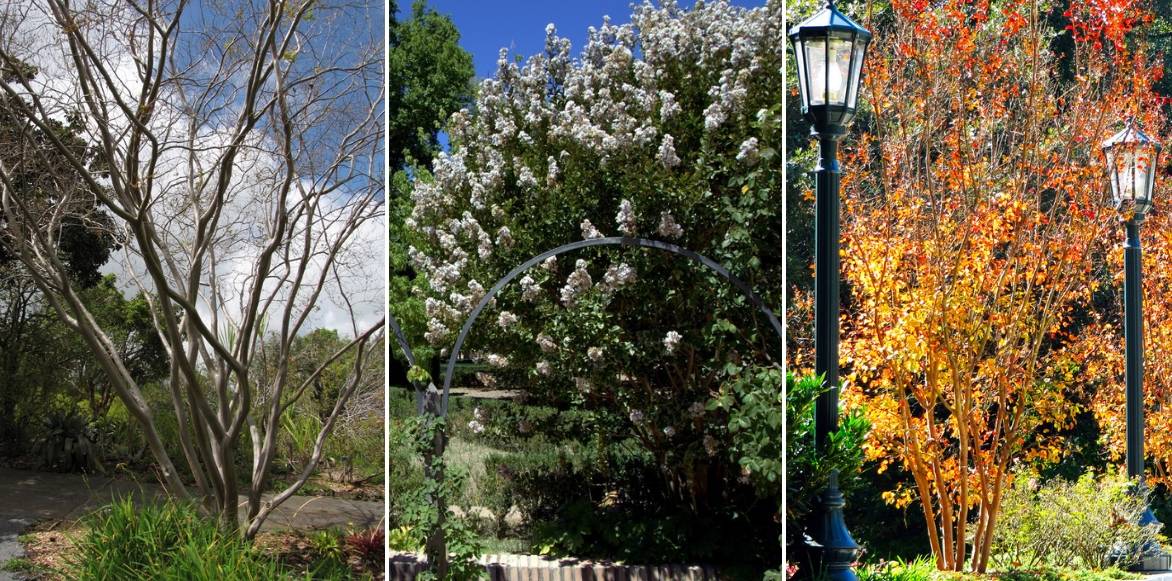
The crepe myrtle through the seasons: Beautiful natural silhouette in late winter (photo Forest and Kim Starr) / Lagerstroemia in full summer bloom (photo Manuel m.v.) / Foliage ablaze in autumn (photo David)
Diseases and Pests
Crape myrtles are susceptible to powdery mildew, a disease caused by microscopic fungi, noticeable by the appearance of a white, powdery coating on the foliage. Some simple measures can help limit or even prevent powdery mildew. Here’s what you can do as a preventive measure:
- Water at the base of the bush without wetting the foliage,
- Encourage air circulation within the bush by opting for thinning pruning,
- Space out plantings,
- Avoid excessive nitrogen fertilisation.
For prevention or treatment in case of a mild infestation, you can use natural preparations such as nettle manure or horsetail decoction. If this isn’t sufficient or the infestation is more severe, treat with a sulphur-based fungicidal spray.
See also our advice sheet dedicated to powdery mildew as well as Diseases and Parasitic Issues of Crape Myrtles (Lagerstroemia).
Propagation: sowing, cutting
Summer lilac can be propagated by sowing, but this process takes more time than other techniques such as propagation by cuttings. Moreover, the young plants obtained may differ from the parent plant (especially if it’s a horticultural variety). Nevertheless, it can be fun to try your luck! Be aware that new seedlings from your sowing will take 3 to 5 years before flowering. To propagate Lagerstroemia, taking semi-woody cuttings in late summer seems to us the most effective propagation method.
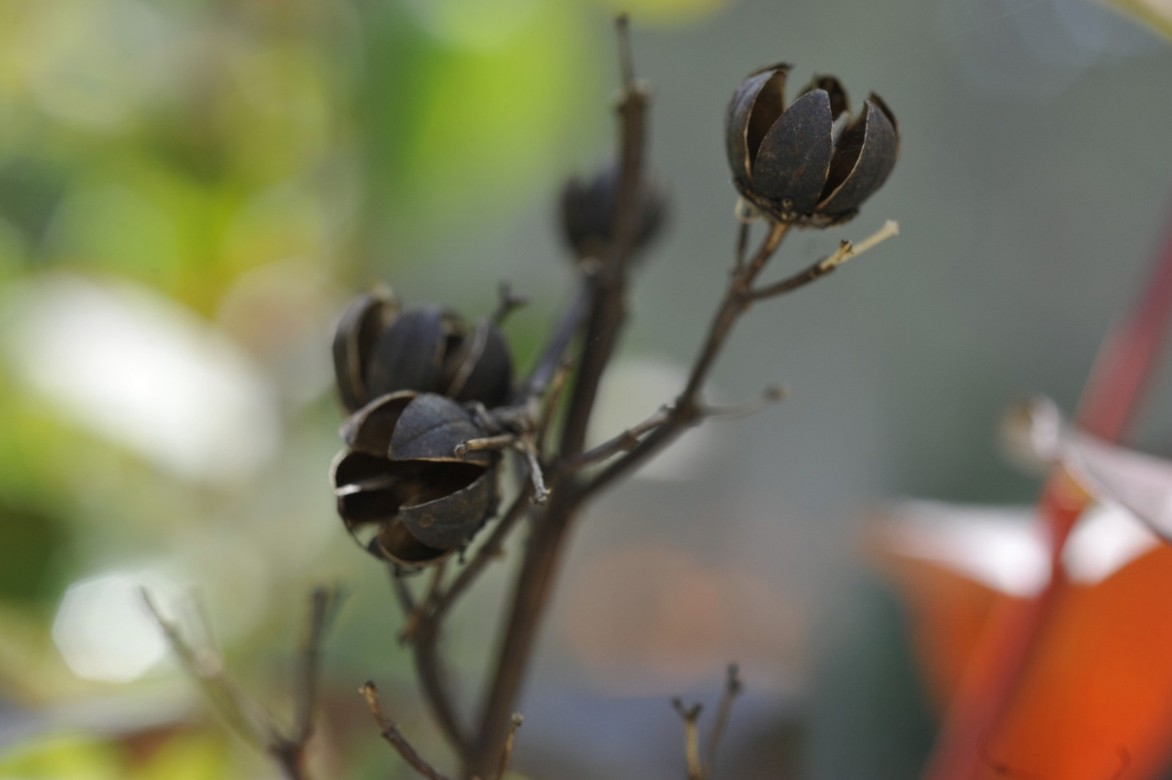
Seed capsules of a Lagerstroemia ‘Arapaho’ (photo Megan Hansen)
Sowing Lagerstroemia
- Place the seeds in cold conditions for one month (vernalisation)
- Then soak them in warm water for 24 hours
- Sow in special sowing compost, then cover lightly
- You can sprinkle with a thin layer of charcoal which reduces damping-off problems
- The soil should remain moist but not waterlogged
- Keep in light (without direct sunlight) between 20°C and 24°C
- Pot on when the young plants have at least two true leaves, into individual pots filled with flowering plant compost (or geranium compost)
- Remember to water regularly
Lagerstroemia seeds generally take 1 to 2 months to germinate, sometimes longer. You can plant your young plants in the garden the following year.
Taking Lagerstroemia cuttings
Cuttings are usually taken from August to September using current year’s stems. The cuttings should be kept in a frost-free location.
Here’s a method to follow:
- Prepare a pot by filling it with special sowing compost or a mixture of compost and coarse sand.
- Water so the substrate is thoroughly moist.
- Take a 15 to 20 cm long section from a non-flowering shoot using sharp, disinfected secateurs
- Remove the leaves from the base, leaving only a few at the top of the stem.
- Plant the cutting in the substrate.
- Firm well around it to ensure good contact between the stem and substrate, and to avoid air pockets
- Cover with a plastic bag, film or cloche to maintain a humid atmosphere
- Keep slightly moist and ventilate once daily to prevent disease or fungal development.
- Keep the cutting under cover during winter to protect it from the cold.
- By late winter, the cuttings should have rooted and you can pot them on into individual pots.
Pairing Summer Lilac in the Garden
To create a tropical-inspired flower bed, opt for a Lagerstroemia with Indian pink flowers, under whose shade an Aspidistra and a Chinese dwarf banana unfurl their broad leaves. A Libertia formosa enhances the exotic spirit of the ensemble. Also consider Phormiums, Carex, Cordylines… You can also pair the Lagerstroemia with other colourful summer blooms: yarrows, agapanthus, daylilies, coneflowers… It also pairs beautifully with Oleander, which offers flowers in similar shades of pink or white.
The crape myrtle can complete this list of plants for an exotic atmosphere.
A crape myrtle can create a romantic flower bed if you choose a pastel-toned variety, such as L. indica ‘Camaïeu d’Eté’, which can be accompanied by a Persian rose ‘Blue Eyes’ with its shifting blue hues. A charming butterfly lavender adds whimsy with its pink bracts. In spring, pink tulips paired with a tapetum of Caucasian forget-me-nots highlight the marbled bark of the Lagerstroemia. Also enjoy the beautiful spring flowering of Camassia. For this type of delicate and romantic flower bed, the key is to favour very soft shades of blue, pink, mauve, or white.
You can also pair the Lagerstroemia with other bushes with decorative bark and elegant, even twisted architecture, such as the Strawberry Tree, Arbutus unedo. Also take advantage of the colourful bark of Dogwoods. Similarly, it’s interesting to pair it with other trees or bushes that take on beautiful fiery hues in autumn: Parrotia persica, Cercidiphyllum japonicum, Hornbeam, Dogwoods…


A spring pairing idea: Lagerstroemia indica ‘Camaïeu d’Eté’ with Tulipa fosteriana ‘Flaming Purissima’ at its base and clumps of Brunnera macrophylla ‘Betty Bowring’.


A summer pairing idea: Lagerstroemia indica ‘Camaïeu d’Eté’ paired with clumps of Lavandula stoechas ‘The Princess’ and roses ‘Blue Eyes’.
→ Need more ideas? Visit our guide: “Crape Myrtle, Lagerstroemia: 6 Successful Pairing Ideas”
Did you know?
The name Lagerstroemia comes from Magnus Von Lagerström (1696-1759), a botanist and director of the Swedish East India Company. It was he who, during a journey, discovered the bush and sent it to his friend Linnaeus. The latter dedicated the plant to him by naming it thus.
Certain parts of the lagerstroemia are used in Indian pharmacopoeia as a purgative, energiser, and stimulant.
Useful resources
- Discover our varieties of Lagerstroemia or Crape Myrtle!
- Crape myrtles by colour:
- Find our advice sheet: Successful cultivation of Crape Myrtle (Lagerstroemia) in pots.
- Our tutorial and advice for propagating Crape Myrtle
Frequently asked questions
-
I have had a crape myrtle for several years, but it has never flowered. What should I do?
To flower, the Lagerstroemia needs plenty of warmth and sunshine. If you live in a region with a cool climate, in the north of France, or if your bush only enjoys sunlight for part of the day, it may struggle to flower. Ideally, if possible, move it to a spot in full sun, for example against a south-facing wall, and sheltered from the wind (wait until spring to move it).
-
In my garden, I have a Lagerstroemia that's a little over 5 years old and its bark is peeling off in strips! What's happening to it?
At maturity, the bark of the Lagerstroemia naturally peels away, revealing beautiful pastel hues. This is a completely natural process as the young plant renews its bark! Avoid pulling off these shreds or touching them to prevent damaging the younger areas of the bark.
- Subscribe!
- Contents
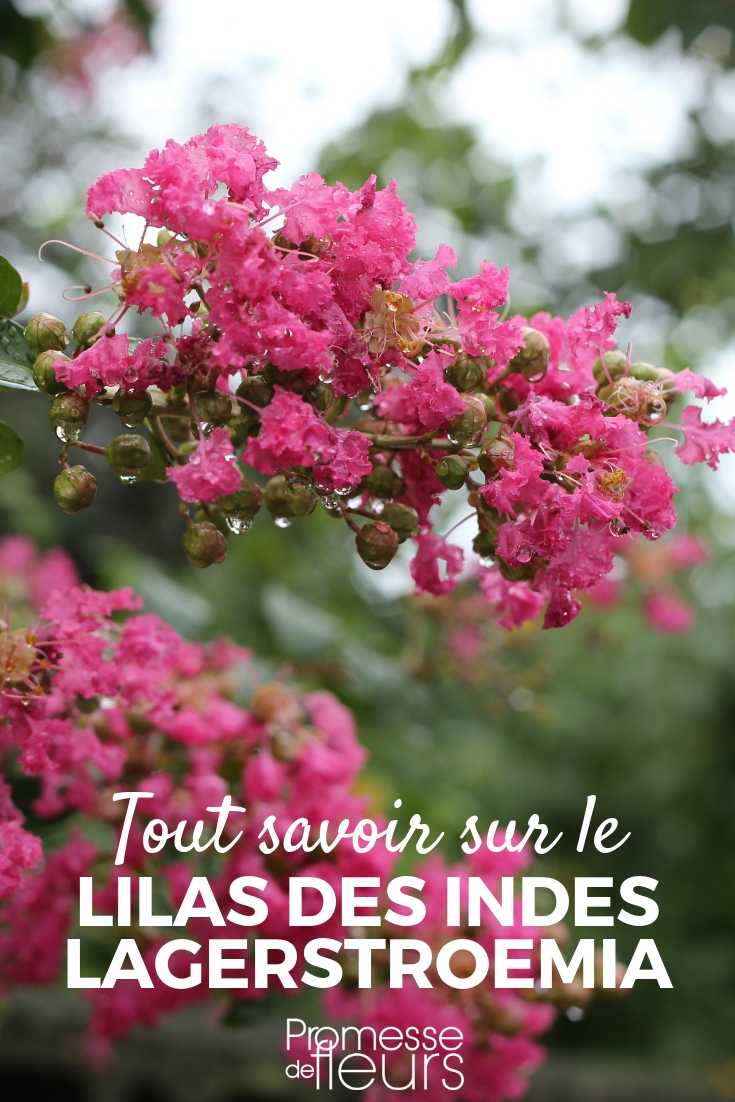


































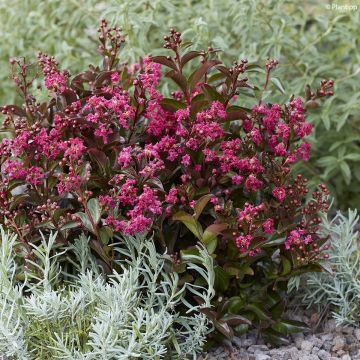
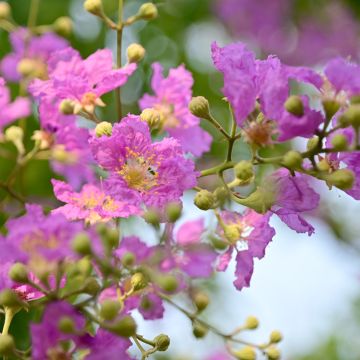
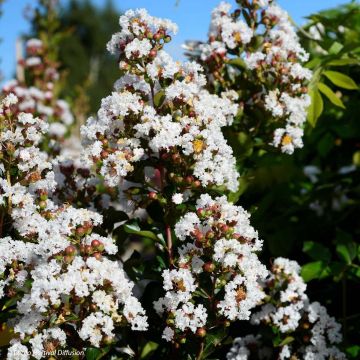
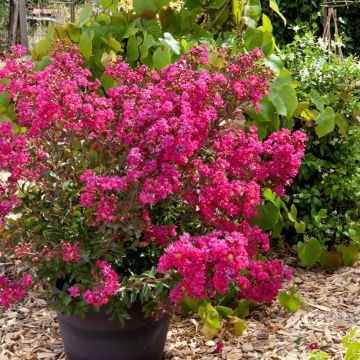
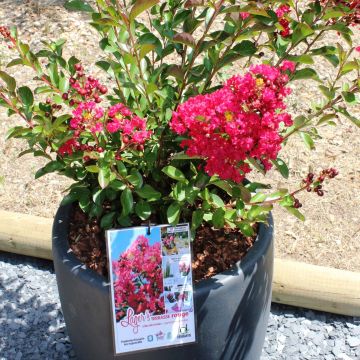

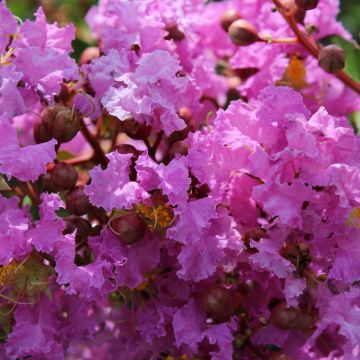
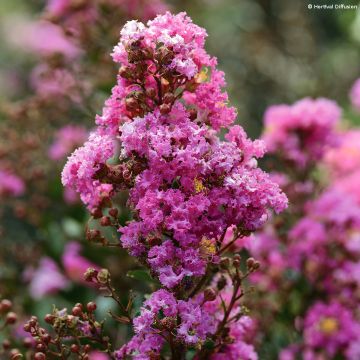
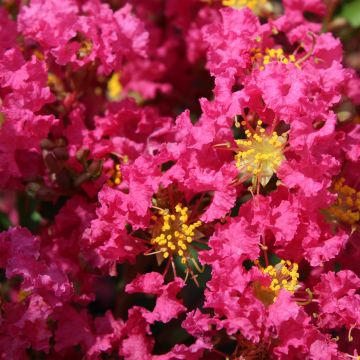
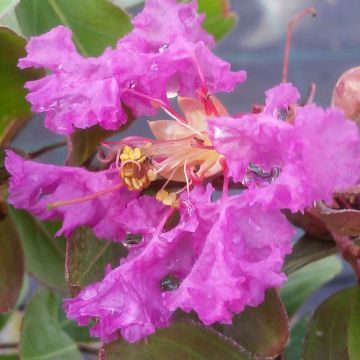
Comments